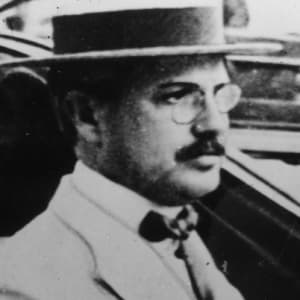
Benjamin Guggenheim
Benjamin Guggenheim was an heir in the wealthy Guggenheim family. Following a trip to Europe, he decided to sail on the maiden voyage of the Titanic.
Synopsis
Benjamin Guggenheim, born in Philadelphia, Pennsylvania, was an heir in the wealthy Guggenheim family. He took up the family mining business, gaining the nickname "Silver Prince". Following a trip to Europe, he decided to sail on the maiden voyage of the Titanic after missing a trip on the Lusitania. Guggenheim died in April 1912 after the ship hit an iceberg and sank.
Early Life
Businessman, member of wealthy Guggenheim family. Born on October 26, 1865, in Philadelphia, Pennsylvania. Sometimes called the "Silver Prince," Benjamin Guggenheim earned his nickname from his interests in that precious metal. He was one of the seven sons of Swiss-born industrialist Meyer Guggenheim. Spending much of his adult life working in family businesses, Guggenheim perished in the Titanic disaster of 1912.
At the age of 20, Guggenheim went to Colorado to handle the family's mines in Leadville. He was inspired to start a smelting operation – the first plant was located in Pueblo and soon more plants were built elsewhere. Smelting business continued to grow and became quite lucrative for the Guggenheims.
After taking a break in Europe, Guggenheim returned to the United States and started building mining machinery. That business later became part of the International Steam Pump Company in 1906. After serving as chairman of the company's executive committee for several years, Guggenheim was elected president in 1909.
The Titanic Disaster
Returning from Europe in 1912, Guggenheim had originally booked a trip on the Lusitania. But that sailing was canceled so that the ocean liner could undergo repairs. Instead of taking the replacement vessel, the Carmania, Guggenheim decided to travel to New York on the maiden voyage of the Titanic, a new ship on the White Star Line. Little did he know when he boarded the ship at Southampton that this decision would prove to be a fatal one.
Late on the night of April 14, the Titanic struck an iceberg and began to sink. Guggenheim and his secretary dressed in their finest evening clothes and assisted women and children with getting on the lifeboats. He told a crew member that "we've dressed up in our best and are prepared to go down like gentlemen."
Guggenheim asked a crew member to deliver a message to his wife Florette. "If anything should happen to me, tell my wife in New York that I've done my best in doing my duty." The couple had been married since 1894 and had three daughters, Benita, Marguerite, and Barbara. Marguerite "Peggy" Guggenheim later became a legendary art collector and patron.
Along with his secretary, Guggenheim had been traveling with his mistress, Leontine Pauline "Ninette" Aubart, a French singer. Guggenheim and his secretary died at sea, but Aubart and her maid made it onto one of the lifeboats and were rescued by the Carpathia. She later returned to France.
Legacy
Grieving, the Guggenheim family was distraught over the loss of one of their own. His brother Daniel told The New York Times that "I feel very bitter against such a state of conditions which made this disaster possible."
In his will, Guggenheim left one-third of his estate to his wife Florette and two-thirds to his three daughters after making roughly $115,000 in charitable donations.




